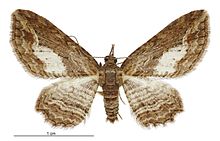| Chloroclystis filata | |
|---|---|
 | |
| Male specimen | |
 | |
| Female specimen | |
| Scientific classification | |
| Domain: | Eukaryota |
| Kingdom: | Animalia |
| Phylum: | Arthropoda |
| Class: | Insecta |
| Order: | Lepidoptera |
| Family: | Geometridae |
| Genus: | Chloroclystis |
| Species: | C. filata |
| Binomial name | |
| Chloroclystis filata | |
| Synonyms | |
| |
Chloroclystis filata, the Australian pug moth, is a species of moth of the family Geometridae. [2] It is native to Australia and is found in the south eastern quarter of Australia and on Norfolk Island. It self-introduced itself to New Zealand in 1960. In Australia host plants are acacias (the blossoms) and Fabaceae (the petals).
